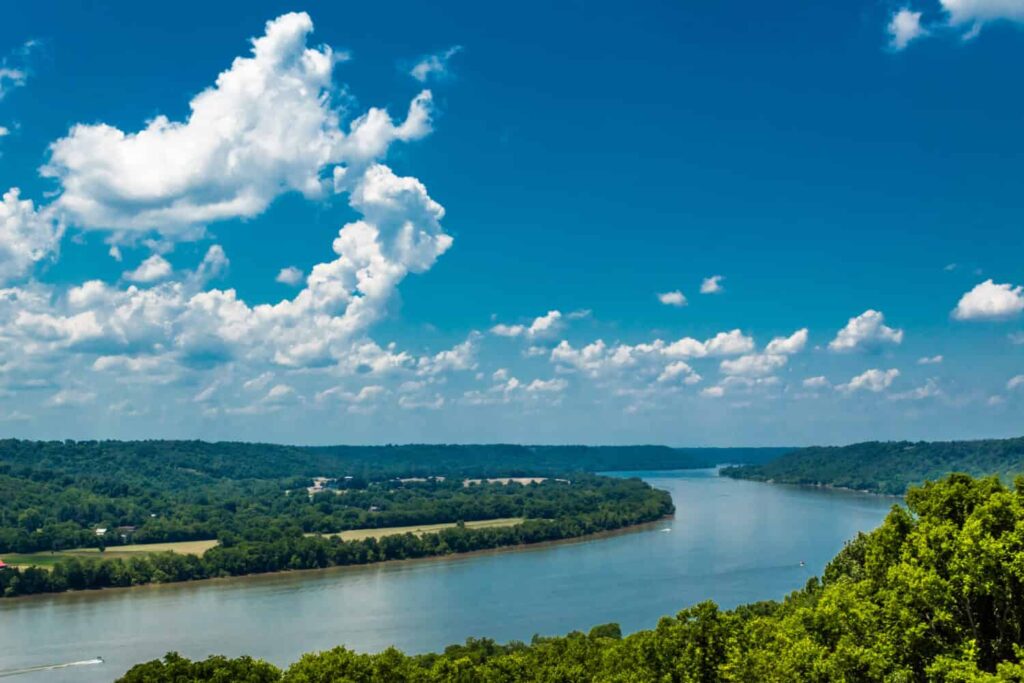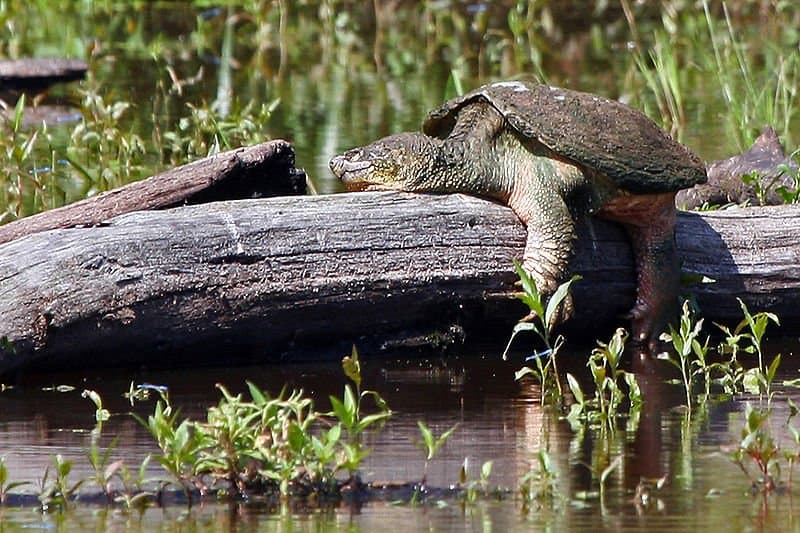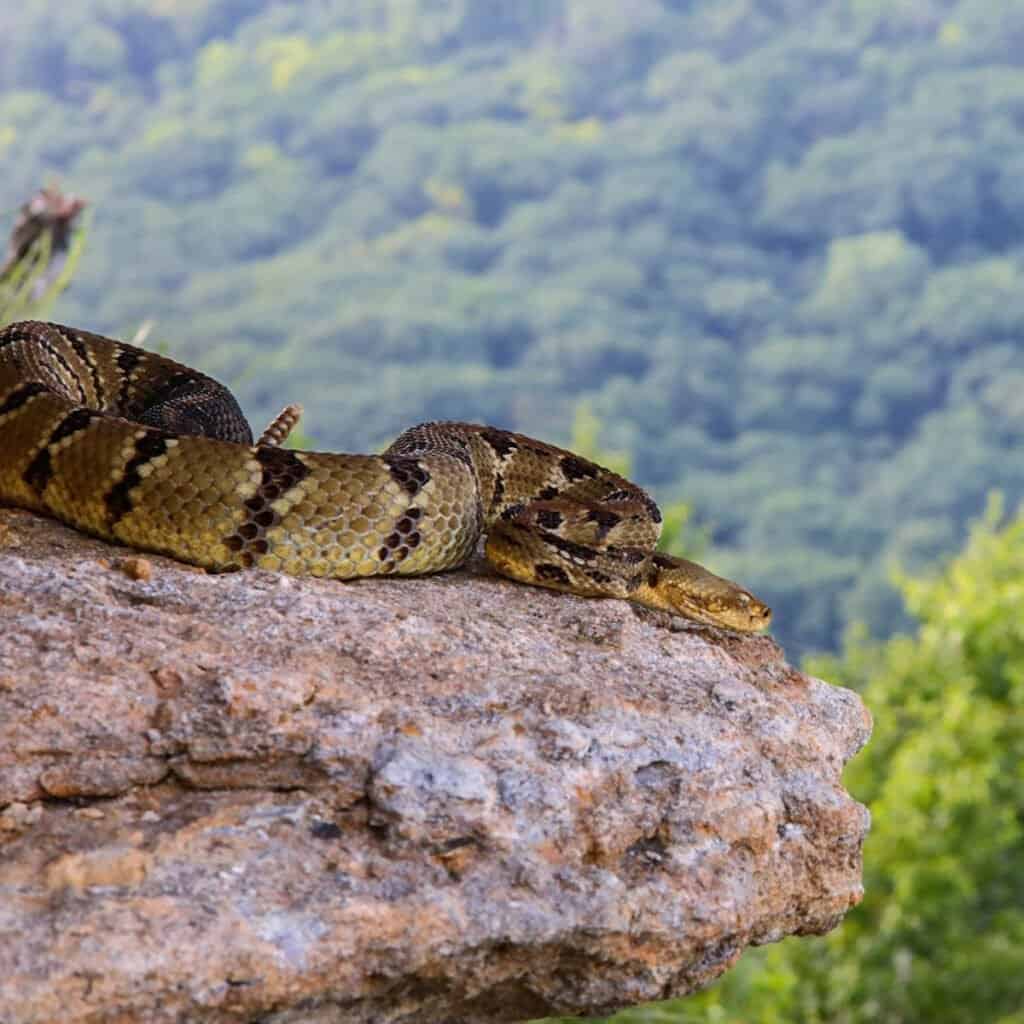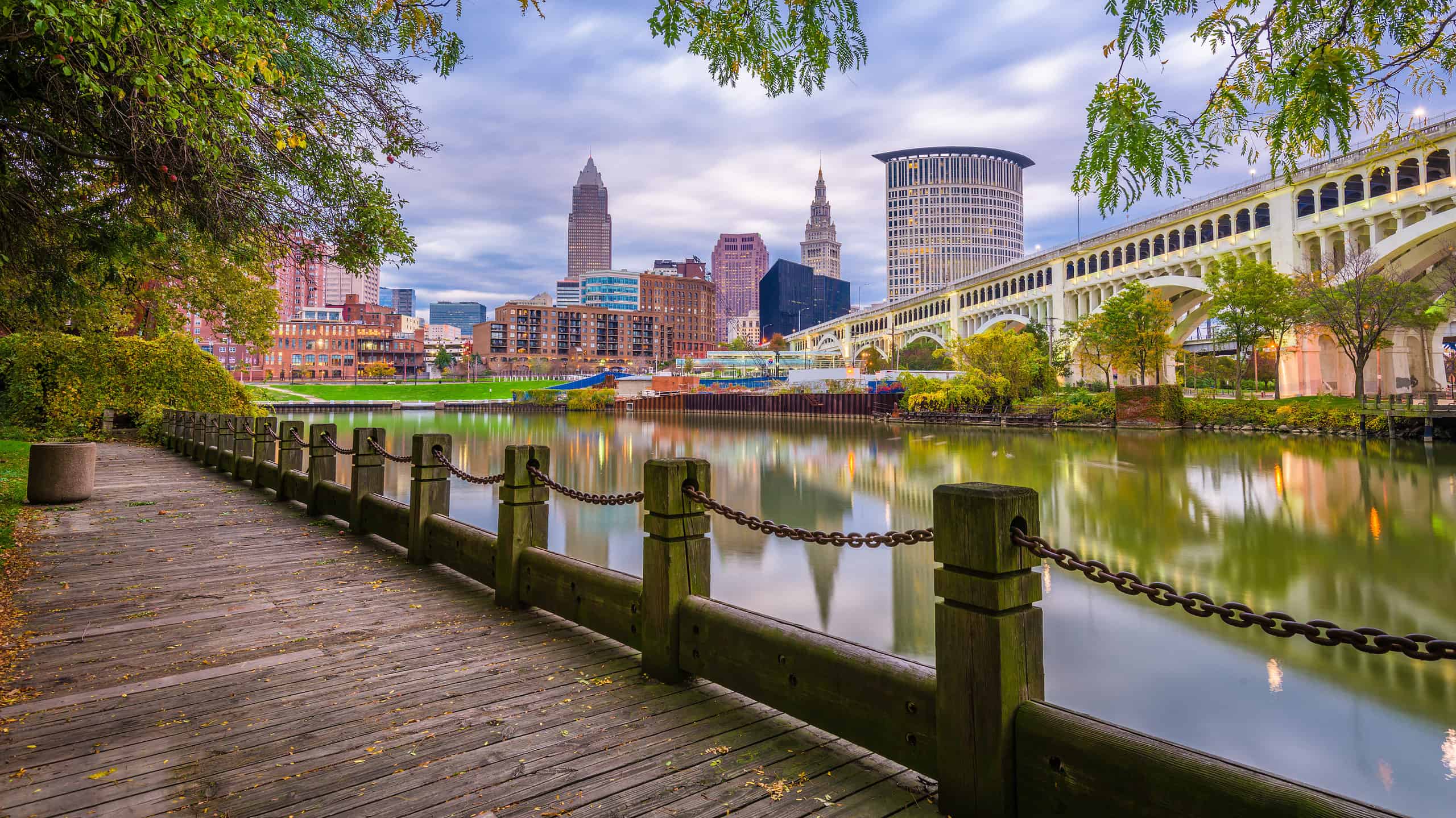
©Corey B Stevens/Shutterstock.com
Ohio takes its name from the Ohio River. It originated from the Seneca word “ohiːyo’, meaning “good river,” “great river” or “large creek.” The Ohio River forms the Midwest state’s southern border. And even though its name means something beautiful, it is part of Ohio’s troubled history with rivers. And even though the river supplies drinking water to 5 million people and is home to more than 150 species of fish, it is still under threat from pollution, according to a report from the conservation advocacy organization American Rivers. Pollution is just one factor that makes rivers in Ohio dangerous to the public.
Other polluted and dangerous rivers include the Cuyahoga River which most remember for catching on fire in 1969. However, this wasn’t necessarily as terrible an event as it sounds. In fact, this disaster helped spur the environmental movement in the United States including the establishment of the first Earth Day.
Why Are Rivers In Ohio Dangerous?
The Cuyahoga River is one of the five great rivers that traverse in Ohio. The others include the Great Miami River, the Maumee River, the Muskingum River, and the Scioto River. Not all of these rivers are meant for swimming. These, along with other tributaries, contain fast-moving undercurrents that threaten to pull any swimmer far below the water’s surface. The various bodies of water around Ohio pose various risk levels. River currents, for example, run fast and strong in the Ohio River, making it generally not the safest place to swim. Floating and submerged debris in the various rivers and lakes also may pose threats of danger. Commercial and private boating traffic may also be dangerous.
Algal bloom, however, is perhaps the biggest threat in several of the bodies of water around the state. Numerous programs exist to help mitigate the problem. The programs monitor the water of the Ohio River and others. However, in many cases, due to the problems, restrictions prohibit swimming and other activities on the waterways.
Let’s take a look at some of the threats that make Ohio’s rivers dangerous.
Severe Risk of Drowning: Rate of Drowning in Ohio

Even if you are a good swimmer, the local drowning rate is average for the country, costing the lives of far too many people.
©jack looney photography/Shutterstock.com
One of the biggest risks of swimming in any body of water including Ohio’s rivers is drowning. According to American Whitewater’s report on Ohio’s rivers, 29 of the 38 recorded accidents resulted in death. Whether playing by the rivers or swimming in them without wearing a personal flotation device, unpredictable conditions, and personal errors account for these fatalities. Even though rivers encourage tourism and offer recreational activities, some of the fatalities happened while kayaking or during other water activities. As recently as August 2023, a community mourned the drowning of a man in the Ohio River.
According to the City of Columbus, statistics show that 74% of deaths from drowning or water-related injuries involved children younger than five years old. And that drowning remains in the top five causes of unintentional injury-related death from birth to 54 years old. Drowning can be hard to see as well as it can be silent and happen quickly in 20 to 60 seconds.
List of Significant Rivers in Ohio
Additionally, Ohio has several significant rivers flowing through, including:
- Ohio River
- Cuyahoga River
- Grand River
- Auglaize River
- Black River
- Blanchard River
- Conneaut Creek
- Great Miami River
- Kokosing River
- Little Muskingum River
- Paint Creek
- Sandusky River
- Scioto River
- Stillwater River
- Tuscarawas River
Natural Dangers of Ohio’s Rivers

October at Berea Falls, Cleveland Ohio
©Jason Kostansek/iStock via Getty Images
Flood Areas and Water Levels
If a river’s bank is dry and its water overflow, river flooding occurs. Water levels rise due to many natural and unnatural occurrences including rapid snowmelt, heavy rainfall, dam failures, and ice jams. A backup of water can also occur when a river is blocked by a build-up of debris. Rivers in Ohio experience these issues and present dangers when it comes to flooding.

River flooding is dangerous due to multiple reasons, including that 66% of flood-related deaths are due to drivers attempting to drive through water that is too deep.
©Tina Gutierrez/Shutterstock.com
Some of the most significant floods in Ohio include the March 1913 Flood, the Xenia Flood of 1886, the Flood of 1959, the Shadyside Ohio Flooding of 1990, and the Independence Day Flood of 1964. One of the worst weather disasters in the state’s history was the flood in 1913, called the Great Dayton Flood. It occurred along the Great Miami River. This river is a tributary of the Ohio River and is approximately 160 miles long. It runs in southwestern Ohio and Indiana and flows south through the cities of Sidney, Piqua, Troy, Dayton, Middletown, and Hamilton. The river’s entire watershed flooded including the downtown business district of Dayton. This flood resulted in the creation of the Miami Conservancy District, the first major floodplain engineering project not only in Ohio but also in the United States.
How to Stay Safe and Prevent Flooding
Ohio prevents flooding like any other state. It urges residents to clean their gutters, downspouts, and splash pads, along with any nearby drainage ditches or storm drains. Cities clear snow and ice away from foundations, and deploy temporary flood barriers, such as portable flood gates or shields, sandbags, inflatable floodwalls, and flood skirts. In fact, only 651,016 properties in Ohio have greater than a 26% chance of being severely affected by flooding over the next 30 years. This represents 16% of all properties in the state.
River Flow Rates
River flow rates vary based on seasons. According to the Ohio State Department of Health, rivers are fastest during the spring in the Midwest. This is due to melting snowpack and ice which create fast currents. This water is difficult to swim in because it is cold and rapidly flowing. Water picks up speed in a gorge because water flows faster when it runs through a constricted space.
River currents in the winter may be a bit calmer than in the spring, however, the waters still pose dangers. Due to the frigid temperatures, rivers in Ohio in the winter are difficult to swim in, and experts advise against it. If you are ice fishing or on a boat on a river in Ohio during the winter, make sure you are wearing your life jacket and warm clothing in case you find yourself in the water!
Swimmers may try to jump in the fresh waters in the warm fall months, which can threaten their health. Cold rivers in Ohio are dangerous because swimmers can succumb to cold water shock. Freezing waters cause unwanted stress on a person’s body. Heart and breathing rates rise, and muscles can lock up in minutes, causing paralysis.
Geographical Dangers
Even during times when rivers flow more calmly, it doesn’t mean there aren’t dangers lurking in the waters. Logs, rocks, underwater roots and trees, and other vegetation can trap swimmers under the water during any season. Large logs and rocks also tip over rafts, canoes, and kayaks, so it is always important to wear water floatation devices while in the water at all times.
Algae blooms are perhaps what makes rivers in Ohio dangerous. Numerous programs exist to help mitigate the problem. These programs monitor the water of the Ohio River and others. However, in many cases, restrictions are placed on the waterways, and swimming or other activities are not permitted.
Wildlife and Animals

Black bears are good swimmers and will hunt for fish in rivers and lakes.
©Mark Caunt/Shutterstock.com
Ohio is home to a diverse array of wildlife. Though most animals and fish that inhabit Ohio’s rivers pose no threat to humans, there are some species that make rivers in Ohio dangerous.
Bears
According to the Ohio Department of Natural Resources, throughout history, black bears roamed the Buckeye State. However, due to unregulated hunting and habitat loss, the bears disappeared by 1850. Today, the midwest state is once again home to a growing population of black bears. It is a small population of around 50 to 100 individual bears.
If you encounter a black bear, they are far more afraid of humans than they are intentionally aggressive toward them. However, attacks are not unheard of, and they usually live near water sources. If you do see one, slowly back away and calmly walk away from the bear. Running or trying to climb a tree is more likely to provoke the bear to chase or attack you.
Channel Catfish

Channel catfish have sharp barbs on their faces. If a barb catches you, it can rip open your skin and lead to complications.
©Aleron Val/Shutterstock.com
Tales of the size of catfish in the Ohio River are mammoth! These rumors swirled after the Silver Bridge that spanned over the Ohio River, connecting Point Pleasant, West Virginia, and Gallipolis, Ohio, collapsed in 1967. People said there were channel catfish large enough to swallow a human whole! However, there has never been an official confirmation, with the largest in Ohio weighing 37 pounds.
As common inhabitants in Ohio rivers, anglers catch channel catfish often and for sport. Their presence makes rivers in Ohio dangerous because of their barbs. These barbs inject proteins into the skin when they sting humans. It is a protective measure used by the catfish to avoid being captured. In most cases, the proteins just sting. However, many incidents aren’t harmless. People can experience severe pain and complications of secondary infections that require antibiotics.
Common Snapping Turtle

Smaller snapping turtles are frequently seen sunning themselves on logs in Ohio waters.
©https://www.flickr.com/people/sherseydc/, CC BY 2.0, via Wikimedia Commons – Original / License
Ah, snap! While turtles look friendly and cute, the common snapping turtle is a species that makes rivers in Ohio dangerous. These reptiles can grow as large as 20 inches and weigh up to 20 pounds when fully grown. Snapping turtles swim in Ohio rivers, hide on debris, and blend into their surrounding habitat. With powerful jaws designed to crack the shells of other turtles, they are a threat to humans. The reptile can snap off fingers and cause serious harm such as infections after they create the wound.
Northern Copperhead

Northern Copperhead snakes are regularly found near the waters of Ohio.
©iStock.com/David Kenny
The Northern Copperhead is a venomous snake that lives near bodies of water. They may even swim in the water, making this another reptile that makes rivers in Ohio dangerous. Though they don’t seek out humans and are not an aggressive species, they will bite if they feel threatened. The venomous snake is frequently mistaken for the harmless watersnake, so just be aware of medium-sized snakes covered in beautiful brown to orange patterns. They also have pale-colored upper lips visible from a distance whereas watersnakes have barred or dark upper lips. But, it is always better to assume the snake is venomous and move away quickly.
Though rare, their bites can be deadly. They are the least toxic bites of venomous snakes in the United States. Recovery requires antivenin therapy in some cases, but usually not. Again, it is better to assume you will need the antivenom and seek immediate medical care if you are bitten.
Timber Rattlesnake
Timber Rattlesnake

These rattlesnakes are some of the most dangerous reptiles in Ohio’s lakes and rivers.
©bradenjalexander/Shutterstock.com
Another venomous reptile in Midwest waters is the Timber rattlesnake. These venomous snakes frequently swim in and live around water, once again making rivers in Ohio dangerous. The rattlesnake’s ability co camouflage makes it often go unnoticed until it’s too late. The coloring of the snakes allows them to disappear into their surrounding habitat.
Again, Timber rattles are a docile rattlesnake. They rarely strike, though will when they feel it necessary. However, they are technically pit vipers, meaning their venom is deadly.
Eastern Massasauga Rattlesnake

Massaugas are more likely to be found on land, but they are definitely a threat on the shores of Ohio rivers and lakes.
©Vladislav T. Jirousek/Shutterstock.com
This rattlesnake is on the endangered species list. However, the Eastern massasauga rattlesnake is ranked among the top 10 most dangerous animals in Ohio. Again, they rarely attack humans unless provoked or threatened, but when they do, their venom is deadly. The venom takes hold and kills within a matter of only three and a half hours unless antivenom and proper medical care are offered immediately.
The Eastern massasauga rattlesnake prefers damp lowlands in the forests and wet prairies.It once again makes rivers in Ohio dangerous as the species is often found in swampy areas, bogs, and marshes near major waterways.
Sport Fish and Freshwater Fish

Bluegill can be found in Ohio’s lakes and rivers and can be deadly if eaten too frequently.
©RLS Photo/Shutterstock.com
A popular sport in the Midwest state is fishing. Anglers catch fish for sport and for food as fish are high in protein, low in fat, and contain healthy nutrients, such as omega-3 fatty acids. However, the freshwater fish species of Ohio have some restrictions you’ll need to keep an eye on.
Most species of fish found in Ohio are deemed safe for consumption a single time per week and no more. This is due to low-level mercury contamination. This advisory is in place to protect humans from over-consuming the toxin which may kill us otherwise. This includes yellow perch and sunfish, northern pike, and steelhead trout caught in Lake Erie and tributaries. Also, Flathead catfish over 23 inches should only be eaten once monthly.
If you eat the fish here more frequently, you could develop neurological and behavioral disorders. Tremors, insomnia, memory loss, headaches, motor and cognitive dysfunction, and neuro-muscular effects follow, with lifelong effects. And yes, mercury poisoning may even lead to death.
What Are the Most Dangerous Rivers in Ohio
Although safety is important in any waterway, some rivers in Ohio are more dangerous and contribute to more accidents than others. Some of the most dangerous rivers in Ohio include the following.
The Great Miami River

The Great Miami originates at the man-made Indian Lake. It flows south through the cities of Sidney, Piqua, Troy, Dayton, Middletown, and Hamilton.
©Ray Geiger/Shutterstock.com
This tributary of the Ohio River is a beautiful water that flows in southwestern Ohio and Indiana. And though the river may seem tranquil, there are dangers that lurk in its waters. The hidden dangers include deep waters anywhere from 25 to 30 feet deep along with debris in the water such as concrete or even barbed wire. And then the spots that look shallow also pose a danger. The river’s undercurrent can take out your feet and drag you along with it. Also, recent studies show that average bacteria concentrations exceeded state standards at more than half of the sampling sites.
The Ohio River

t=There are a lot of recreational activities on the Ohio River. It is advised to stick to the areas where designated signs say it’s okay to swim.
The Ohio River has multiple risks that make it a dangerous river in the state. These factors include:
- River currents
- Submerged or floating debris
- Recreational and commercial traffic
- Poor water quality
There may be possible human health risks due to water quality conditions. For example, when there is a lot of heavy rain, the stormwater mixes with sanitary waste, and an overflow occurs, which runs into the Ohio River. Also, when river levels are higher than average, stronger than normal currents occur on the Ohio River. Debris, rip currents, and eddies are made in areas along the river where they don’t normally occur.
Conclusion: How to Stay Safe in Ohio’s Rivers
Any river can be dangerous if you don’t follow certain safety precautions. It is important to always stay safe while swimming or partaking in other water activities.
You should always swim with a buddy, and let others know where you are going to swim. It’s important to have someone there who can help you if you get into trouble – or at least alert the authorities that you are in trouble. Also, wear a life jacket whenever you are swimming. This safety tip is the most important thing you can do to prevent drowning.
Also, since any river in Ohio can be dangerous, make sure you are aware of your surroundings. Water levels can rise quickly, and the floor can fall away dramatically. It’s important to remember that rivers are natural areas that can change quickly. And, don’t swim in areas not designated for swimming. Often, areas of the rivers that aren’t marked for swimming are that way for a reason. Whether it be due to algae blooms or strong undercurrents, the experts don’t mark areas just for fun.
To see your surroundings better, make sure you don’t swim after dark. It makes it challenging to see dangers lurking in the river as well as deep spots. Also avoid swimming in rivers after heavy rain, especially heavy rain upstream. Even if it didn’t rain in your swimming area, rainfall upstream can cause water levels to rise downstream.
Again, any river in Ohio can pose a danger. Make sure you use common sense, and follow the above rules to stay safe!
Thank you for reading! Have some feedback for us? Contact the AZ Animals editorial team.








